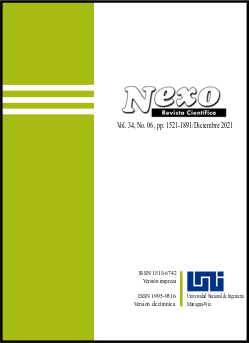Coconut fiber as improvement additive in the preparation of blocks
DOI:
https://doi.org/10.5377/nexo.v34i06.13125Keywords:
Breaking stress, masonry, mortar mixAbstract
The incorporation of coconut fiber in the blocks elaborated in the city of Bluefields, provided relevant information during the evaluation of its physical and mechanical properties, through the interpretation of the data obtained from the compression tests carried out at the Julio-Adolfo Laboratory of the Central American University (UCA). These blocks were analyzed in the different setting days, which are 7 and 28 days respectively, analyzing 9 blocks for each test, 6 blocks of 6" (3 with 5% of additive and 3 with 20% of additive) and 6 blocks of 4" (3 with 5% of additive and 3 with 20% of additive. The results of the tests determined that the blocks had evidence that the implementation of the fibers allows the concrete the adherence of the materials allowing the concrete to present normal cracking after the failure, but it is controlled by the fibers that prevent the prolongation of these cracks making them end there, providing ductility.
Downloads
1330
Downloads
Published
How to Cite
Issue
Section
License
Copyright (c) 2021 Universidad Nacional de Ingeniería

This work is licensed under a Creative Commons Attribution 4.0 International License.
The authors who publish in Nexo Scientific Journal agree to the following terms:
- Authors retain the copyright and grant the journal the right of the first publication under the license Creative Commons Attribution License, which allows others to share the work with a recognition of the authorship of the work and the initial publication in Nexo Scientific Journal.
- Authors may separately establish additional agreements for the non-exclusive distribution of the version of the work published in the journal (for example, in an institutional repository or a book), with the recognition of the initial publication in Nexo Scientific Journal.
- Authors are allowed and encouraged to disseminate their works electronically (for example, in institutional repositories or in their own website) before and during the submission process, as it can lead to productive exchanges, as well as earlier and greater citation of published works.










